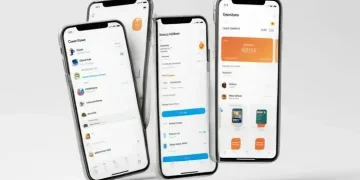Mastering Student Loan Refinancing for Maximum Savings.

Student loan debt is one of the most significant financial burdens facing millions of Americans. For those who completed their education and secured a stable income, carrying high-interest loan debt can feel like constantly climbing a steep hill.
Refinancing your student loans is not just about managing debt; it is a powerful financial tool that can dramatically reduce your interest rate, lower your monthly payment, and shave years off your repayment timeline, potentially saving you tens of thousands of dollars over the life of the loan.
This in-depth guide provides a strategic roadmap for navigating the student loan refinancing process. We’ll cover when it makes sense to refinance, how to maximize your application, and the critical factors to consider before leaving federal loan protections behind.
🛑 Federal vs. Private: Understanding the Crucial Trade-off
The decision to refinance is fundamentally a choice between security and savings. When you refinance federal student loans (like Stafford or PLUS loans) with a private lender, you gain access to lower interest rates but permanently lose the benefits unique to the federal system.
Benefits You Lose When Refinancing Federal Loans
- Income-Driven Repayment (IDR) Plans: These plans cap your monthly payment based on your income and family size, offering a vital safety net during periods of unemployment or low earnings.
- Forbearance and Deferment Options: The federal government offers extended and flexible options to temporarily pause payments during financial hardship. Private lenders offer these benefits, but typically on much stricter terms.
- Loan Forgiveness Programs: You lose eligibility for Public Service Loan Forgiveness (PSLF) and IDR-based forgiveness programs (after 20 or 25 years of payments).
Benefits You Gain with Private Refinancing
- Lower Interest Rates: This is the primary driver. Strong applicants with excellent credit can often drop their interest rate by 1% to 3%, leading to massive savings.
- Flexible Terms: Private lenders allow you to choose new loan terms (e.g., 5, 7, 10, 15, or 20 years) to tailor your monthly payment and total cost.
- Simplified Payments: If you have multiple loans, refinancing consolidates them into a single loan with one monthly payment.
The Golden Rule: If you work in a non-profit or government role and are pursuing PSLF, or if your income is volatile and you rely on IDR plans, do not refinance your federal loans. Refinancing is best suited for those with stable high incomes who prioritize maximum long-term savings.
💰 The Ideal Candidate Profile for Refinancing
Lenders look for predictability and low risk. Meeting these criteria will ensure you receive the lowest advertised Annual Percentage Rate (APR).
1. Excellent Credit Score (720+)
A FICO score above 720, and ideally above 760, signals to lenders that you are a reliable borrower. If your score is low, consider taking 6 to 12 months to improve it before applying.
2. Stable Employment and Income
Lenders require a history of stable, predictable income to prove you can manage the payments comfortably. A low Debt-to-Income (DTI) ratio—the percentage of your gross monthly income that goes toward debt payments—is essential. Aim for a DTI under 40%.
3. Graduation and Degree Completion
While some lenders refinance loans for students who did not graduate, the best rates are usually reserved for those who have completed a four-year degree or a graduate program, as this often correlates with higher earning potential.
4. A Co-Signer (If Necessary)
If your credit score or income history is lacking, applying with a creditworthy co-signer (like a parent) can often secure a much better rate. Once you establish a strong payment history (usually 12–24 months), you can typically apply to have the co-signer released from the loan.
🔎 How to Master the Refinancing Application Process
The key to maximizing your savings is shopping around. Do not accept the first offer you receive.
Step 1: Gather Your Documentation
Have the following readily available:
- Original loan statements (showing current principal, interest rate, and servicer).
- Proof of income (pay stubs, W-2s, or tax returns).
- Identification (Driver’s License).
Step 2: Utilize Pre-Qualification Tools
Most top refinancing companies offer pre-qualification tools. These tools perform a “soft credit check” (which does not harm your score) and provide you with personalized rate estimates.
- Actionable Tip: Use three to five different pre-qualification tools from major lenders (e.g., SoFi, CommonBond, Laurel Road) within a 30-day window to compare rates quickly.
Step 3: Choose the Right Loan Term
Choosing the term is a balance between monthly payment and total cost:
| Loan Term | Monthly Payment | Total Interest Cost | Recommended For |
| Short (5–7 years) | Highest | Lowest | Borrowers prioritizing minimum cost and fast debt payoff. |
| Long (15–20 years) | Lowest | Highest | Borrowers prioritizing lower monthly cash flow. |
Step 4: Fixed Rate vs. Variable Rate
- Fixed Rate: The interest rate remains the same for the entire life of the loan. This offers certainty and predictability. Recommendation: This is usually the safer choice, especially if you plan on taking 10+ years to repay.
- Variable Rate: The rate can fluctuate based on a market index (like SOFR). It often starts lower than a fixed rate but can increase over time. Recommendation: Only consider a variable rate if you plan to pay off the loan quickly (5 years or less) and can tolerate the risk of rate hikes.
📈 The Power of 2%: A Real-World Example
To illustrate the dramatic impact of even a small interest rate reduction, consider this common scenario:
- Original Loan Balance: $80,000
- Original Rate & Term: 6.5% APR over 10 years
- Total Interest Paid: $29,679
Now, imagine refinancing and securing a 4.5% APR over the same 10-year term:
- Refinanced Rate & Term: 4.5% APR over 10 years
- Total Interest Paid: $20,131
- Total Savings: $9,548
A mere 2% rate drop saves nearly $10,000. These savings can be immediately reinvested into tax-advantaged accounts like a 401(k) or IRA, dramatically accelerating your wealth-building timeline.
🎯 Conclusion: Seizing Control of Your Financial Future
Refinancing student loans is one of the most proactive steps you can take to solidify your financial position after graduation. It transforms high-interest, fragmented debts into a single, optimized liability.
The process demands diligence: shop around, compare multiple offers, and rigorously assess whether losing federal protections is worth the interest savings. For the vast majority of high-earning professionals, the savings are too substantial to ignore. Take control today and stop letting high-interest debt erode your hard-earned income.






